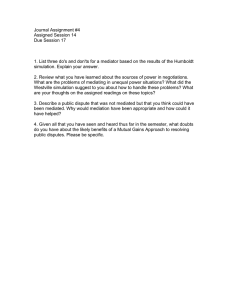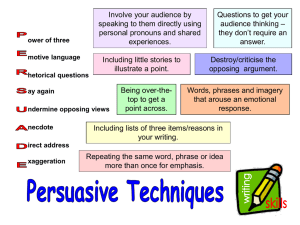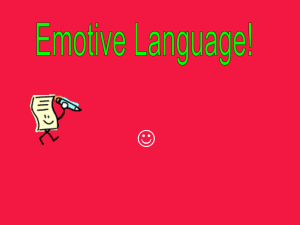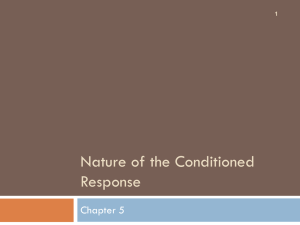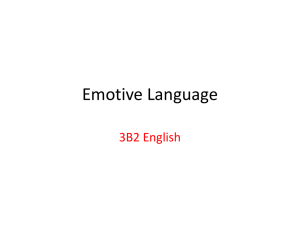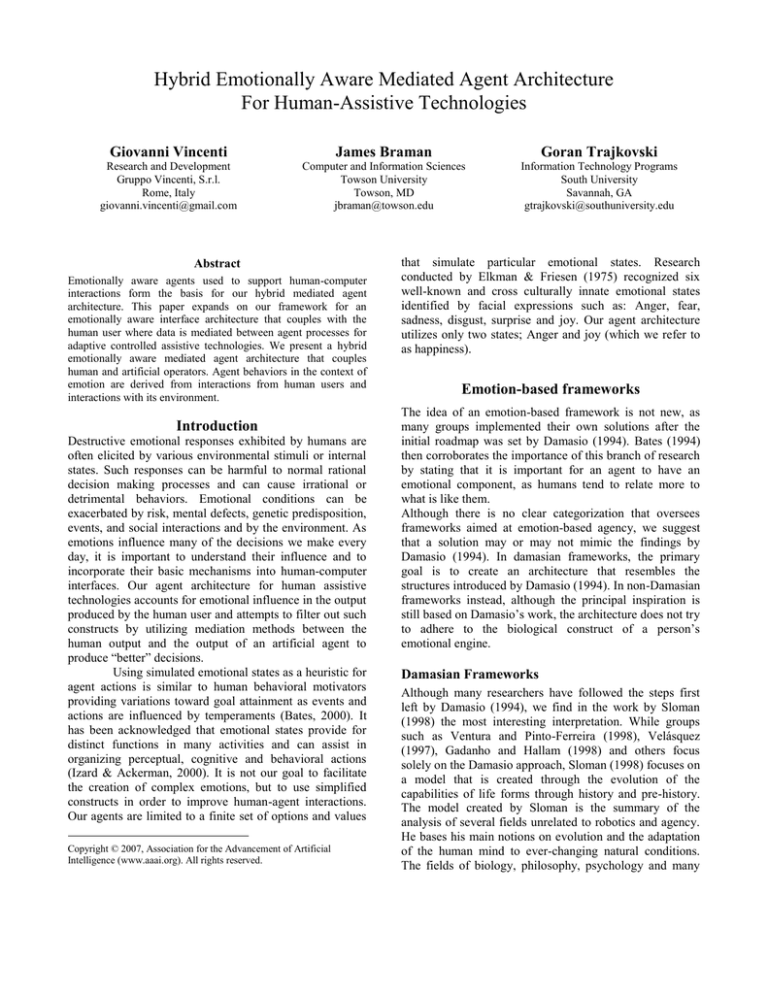
Hybrid Emotionally Aware Mediated Agent Architecture
For Human-Assistive Technologies
Giovanni Vincenti
James Braman
Goran Trajkovski
Research and Development
Gruppo Vincenti, S.r.l.
Rome, Italy
giovanni.vincenti@gmail.com
Computer and Information Sciences
Towson University
Towson, MD
jbraman@towson.edu
Information Technology Programs
South University
Savannah, GA
gtrajkovski@southuniversity.edu
Abstract
Emotionally aware agents used to support human-computer
interactions form the basis for our hybrid mediated agent
architecture. This paper expands on our framework for an
emotionally aware interface architecture that couples with the
human user where data is mediated between agent processes for
adaptive controlled assistive technologies. We present a hybrid
emotionally aware mediated agent architecture that couples
human and artificial operators. Agent behaviors in the context of
emotion are derived from interactions from human users and
interactions with its environment.
1
Introduction
Destructive emotional responses exhibited by humans are
often elicited by various environmental stimuli or internal
states. Such responses can be harmful to normal rational
decision making processes and can cause irrational or
detrimental behaviors. Emotional conditions can be
exacerbated by risk, mental defects, genetic predisposition,
events, and social interactions and by the environment. As
emotions influence many of the decisions we make every
day, it is important to understand their influence and to
incorporate their basic mechanisms into human-computer
interfaces. Our agent architecture for human assistive
technologies accounts for emotional influence in the output
produced by the human user and attempts to filter out such
constructs by utilizing mediation methods between the
human output and the output of an artificial agent to
produce “better” decisions.
Using simulated emotional states as a heuristic for
agent actions is similar to human behavioral motivators
providing variations toward goal attainment as events and
actions are influenced by temperaments (Bates, 2000). It
has been acknowledged that emotional states provide for
distinct functions in many activities and can assist in
organizing perceptual, cognitive and behavioral actions
(Izard & Ackerman, 2000). It is not our goal to facilitate
the creation of complex emotions, but to use simplified
constructs in order to improve human-agent interactions.
Our agents are limited to a finite set of options and values
Copyright © 2007, Association for the Advancement of Artificial
Intelligence (www.aaai.org). All rights reserved.
that simulate particular emotional states. Research
conducted by Elkman & Friesen (1975) recognized six
well-known and cross culturally innate emotional states
identified by facial expressions such as: Anger, fear,
sadness, disgust, surprise and joy. Our agent architecture
utilizes only two states; Anger and joy (which we refer to
as happiness).
Emotion-based frameworks
The idea of an emotion-based framework is not new, as
many groups implemented their own solutions after the
initial roadmap was set by Damasio (1994). Bates (1994)
then corroborates the importance of this branch of research
by stating that it is important for an agent to have an
emotional component, as humans tend to relate more to
what is like them.
Although there is no clear categorization that oversees
frameworks aimed at emotion-based agency, we suggest
that a solution may or may not mimic the findings by
Damasio (1994). In damasian frameworks, the primary
goal is to create an architecture that resembles the
structures introduced by Damasio (1994). In non-Damasian
frameworks instead, although the principal inspiration is
still based on Damasio’s work, the architecture does not try
to adhere to the biological construct of a person’s
emotional engine.
Damasian Frameworks
Although many researchers have followed the steps first
left by Damasio (1994), we find in the work by Sloman
(1998) the most interesting interpretation. While groups
such as Ventura and Pinto-Ferreira (1998), Velásquez
(1997), Gadanho and Hallam (1998) and others focus
solely on the Damasio approach, Sloman (1998) focuses on
a model that is created through the evolution of the
capabilities of life forms through history and pre-history.
The model created by Sloman is the summary of the
analysis of several fields unrelated to robotics and agency.
He bases his main notions on evolution and the adaptation
of the human mind to ever-changing natural conditions.
The fields of biology, philosophy, psychology and many
more all contributed to the refinement of our understanding
of human control modules.
Non-Damasian Frameworks
mediation. These last two modules can be utilized, in order
to take full advantage of the framework presented in this
work. We will now describe each element as an individual
component of this architecture.
The application of Camurri and Coglio (1998), based on
the model created by Camurri et al. (1997), works in a
setting of the performing arts, introduces a framework
where the agent works by observing and being emotionally
influenced by a dancer, creating outputs of music and
rhythm based on its internal emotional state. A
macroscopic analysis reveals several components of
control. There are five active components: Input, Output,
Reactive, Rational and Emotional. Each component deals
with a different aspect of the agent.
Introduction to the hybrid architecture
The work described in this paper is an innovative
framework that can fit many scenarios. Although the
original work was conceived as a stand-alone agent,
described in Vincenti, Braman and Trajkovski (2007), we
have extended the first concept to fit a larger set of
applications. Figure 1 shows the framework in its full
operative setting.
Figure 2: Architecture of the Emotion-Based Agent core
Emotion-Based Agent
The Emotion-Based Agent is the core component of this
framework. Leaving out aspects of meta-cognitive states
this framework resembles the Camurri architecture
(Camurri et al., 1997) as we have adopted the model and
modified certain elements as shown in Figure 2. As shown,
this model utilizes direct communication between modules
which influences the final output of the system, especially
with the combination of rational and emotional decisions
which influence the agents final output. We believe that the
current instance of the agent’s emotional state should have
a direct influence on the totality of actions which are
allowed by the rational module.
Figure 1: Hybrid emotionally aware mediated agent architecture,
with F1 and F2 representing centers of information fusion
This framework is designed keeping modularity in mind.
We can allow an agent to function solely on the emotionbased engine, thus bypassing completely both fusions,
designated by the labels F1 and F2. It is also possible to
allow a human to interact with the emotion-based agent
directly, without any safeguarding mechanisms provided
through the expert controller process and the second
Figure 3: Detailed view of the “Emotional” module
Camurri and Coglio (1998) created a framework that was
influenced only by external events. Our approach extends
this model to accommodate internal states as well. We
believe that this is a crucial extension, especially when
operating in a multi-agent environment. Therefore we
created an elaborate Emotional module, composed of four
components: Genetic, Internal, Interagent Verbal and
Interagent Non-Verbal. Figure 3 shows the interaction of
these modules.
The Genetic component works as a mastermind and sets up
the other modules by creating a weight system that will be
used in order to compute the overall output from the
Emotional module. We included this component to add
because some people seem to be influenced more by what
others say, while some others may be extremely
emotionally unstable from personal causes. We felt the
need to analyze this relationship among factors and build it
into our framework.
The Internal component analyzes information about the
agent and elaborates part of the emotional state. One aspect
that is monitored by this component is, for example, the
time elapsed in the simulation, with the agent unable to
either find clues or reach the overall goal. As time goes on,
the morale of the agent may lower. The rate at which the
morale of the agent is affected by internal events is dictated
by its genetic predisposition.
The Interagent Verbal component instead monitors
communications with other agents. Such communications
will consist in the exchange of clues. Each clue will be
dictated by where the agent “believes” the goal is. Along
with the belief, there is a weight assigned to the
communication. The weight indicates the emotional state
of the agent that is communicating the information. The
agent will internalize both the belief as well as the
emotional state of the other agent. The emotive component
of the communication will affect the agent’s own
emotional state at a rate dictated by the genetic component.
The Interagent Non-Verbal component relies on the
concept that, in society, it is often easy to be able to guess
what mood a person is in by simply looking at them. Our
agents do not only advertise their emotional state through
communications, but also visually. When an agent senses
the presence of other agents and interacts, this component
will analyze and read the apparent emotional state of its
peers. Also in this case, the rate at which the agent will
internalize emotions is set by the genetic component.
Interfacing the Human and the Artificial Agent
The coupling of the human and the agent happens through
direct interaction between the interfaces of the two agents.
The interface is based on the notion of an emergent
coupling interaction occurring between them. The interface
between these agents abstractly is a mediation itself. The
non-human agent in the system learns from its interactions
with the human agent while utilizing its own knowledge
about the current situation and building on its previous
knowledge. Agents in some instances may have inborn
schemes and understanding of the world, especially in the
case of the expert controller agent. The interface between
them should be as non-invasive and as natural as possible
to create a dynamic and adaptable system where each agent
can learn and adjust from various forms of interaction. The
impact of the coupling process to the emotion based agent
and the controller agent is interpreted and output for use in
the meditation 1 module labeled F1 (Figure 1). The
parameters that are passed to the mediation one module are
derived by: 1. The Emotion based agent senses
environmental conditions and various input from the
human user (or other agents). 2. The human or controller
agent generates data by its interaction with the emotional
agent and through its actions caused by interpretations of
the environment.
The interface between the emotionally enhanced agent and
the human user can be accomplished in several ways. First
we can view the Emotion-Based Agent as a meta-agent or
a leader agent in a multi-agent system of emotionally
enhanced set of agents. In this case the multi-agent system
itself is the interface between the human user and the metaagent, of which both becomes part of the multi-agent
system itself. Each agent interacts with other agents or the
environment collecting data to be interpreted by the metaagent whose main goal is to understand the interactions
and intentions of the human. Using a multi-agent approach
to the interface allows us design flexibility on how data is
collected and interpreted by the Emotion Based Agent. In a
real world setting, implementing a system based on
ubiquitous computing strategies would allow for agents to
be deployed in multiple locations surrounding the user
while remaining transparent to normal everyday functions.
The human user would not need to know the state of the
multi-agent system composed of ubiquitous devices. Each
agent would interact with other agents either wirelessly or
in a wired network fashion, while collaborating with the
Meta-Agent (Emotional-Based Agent) about the data is
collecting on its human subject.
Yet another possible solution is to use direct input into the
system such as text, graphical manipulations, or other
detectable hardware input that the system can process.
Following previous research conducted with coupling
interfaces using simple virtual environments (Trajkovski,
Collins, Braman, Goldberg, 2006) we proposed a system
where an individual agent and human user coupled
collectively to form a multi-agent system where the nonhuman agent attempts to learn from human input.
Depending on the need such human input can be collected
directly from physical data manipulations or hardware
input (i.e. keyboard, mouse, joystick, steering wheel,
break/gas pedals, VR gloves etc.). Input would then drive a
simple subsumption architecture where agents would act
accordingly in an attempt to learn and react to the human
user while actively collaborating with the main EmotionalAgent.
F1
The Fusion one (F1) module is an averaging process that
fuses output from both the Emotion based Agent and the
human controller as base parameters. The process of which
the data is sampled from both agents is dependant on the
interface option that was selected for the particular
problem domain. This module outputs data to the Fusion
two (F2) and to the Emotive output selector. The
Emotional based Agent makes decisions based on its own
emotional state and from what it senses from the
environment and the human user. The averaging of these
two outputs are useful because they allow for a equal
weighted approach to the decision making process. For
example of both agents are “angry” then logically there
should be some stressor to both agents for this to occur and
we can say that there is a good reason for this emotional
state. An “angry” decision made by the human user in this
case may be justified and allowed. In contrast if one agent
is very happy and the other is very angry then there is some
problem in one or the others interpretation of
environmental conditions or perhaps there is some
underlying internal condition that is cause the emotion. If
only the non-human agent is angry or stressed while the
human agent is happy, perhaps the human agent in its
positive state has failed to detect important environmental
conditions. If a multi-agent system approach is being used
them there may be an issue in the system itself during the
interacting of the agents that have caused extra stress.
Averaging the output from both of these agents helps to
correct any major differences in emotional states by
essentially compromising on a final decision. If the outputs
from both agents are similar then outcomes will be
relatively equal in control. If output is significantly
different then the output is averaged to a mediated
outcome.
Expert Controller Process
The Expert Controller Process (ECP), as its name implies,
serves as a balancing and “expert” safe-guarding
mechanism for the output of the system. As with decisions
biased by emotions, we now have several agents that are
affected by internal emotional states that are controlling the
system. This process is a separate control agent that makes
decisions without any emotional considerations.
Environmental parameters are sensed by the ECP or
through separate agents (that have no emotional bearing)
and in a reactive fashion base its decisions on logical
deduction schemes. Output from the ECP is directed to the
Fusion two module, where it is mediated with the results of
the Fusion one module.
F2
The second process that fuses inputs into a single, coherent
output (F2) is based on the Fuzzy Mediation model by
Vincenti and Trajkovski (2007a). This method is based on
the evaluation of the absolute difference between inputs of
an expert controller and a novice one. The outcome of this
algorithm is a single mediated value to be passed on to the
object to be controlled.
This mediation will assume that the guardian angel process
is the expert controller, and the output of the first fusion is
the value generated by the novice one. Fuzzy Mediation
functions in three steps.
The first step, analysis of the inputs, evaluates the
difference between two inputs, in our case the outcome of
the first mediation and the direction that the guardian angel
process computes. The deviation is then translated into a
linguistic modifier, chosen from a series of fuzzy sets. A
typical breakdown of the numeric range of possible
deviations may include the following modifiers: “Similar
control”, “Slight deviation” and “Wide deviation”.
Table 1: Mamdani inference rules
If
Then
Inputs are similar
Inputs are slightly different
Inputs are widely different
Shift control to the novice
Maintain the balance unaltered
Shift control to the expert
The second step involves the revision of the weight of
control. As the two controllers perform in similar ways,
more control is given to the novice. Instead, as the
controllers show a wide deviation in the desired direction
of the agent, the expert regains control, overriding the
weight accumulated by the novice controller. The action
taken to modify control is based on the linguistic modifier
associated with the deviation found in the first step, and is
based on a set of Mamdani-style rules (Mamdani &
Assilian, 1975) such as the ones shown in Table 1.
The final step of Fuzzy Mediation is the calculation of the
single output. Such value is computed using the formula
shown below.
MO = µT * EI + µt * NI
Where MO is the mediated output, µ T and µt refer to the
weights of control assigned to the expert (µT) and the
novice (µt), and finally EI and NI are the original inputs
originated by the expert (EI) and the novice (NI).
Previous studies (Vincenti & Trajkovski, 2006; Vincenti &
Trajkovski, 2007a; Vincenti & Trajkovski, 2007b) have
shown the validity of this algorithm. In situations where
the novice is unable to deal with the situation presented at
all, the expert gains full control of the object. On the other
hand, as the controllers perform more similarly, Fuzzy
Mediation allows the novice to control the object without
any interference from the expert.
When operating in this setting, the second fusion will take
as inputs the directional outputs from the first fusion and
the guardian angel process. The single-value output
represents the mediated heading of the agent.
It is important to note that, although the first fusion outputs
both a <direction> and a <emotive state> value, the second
fusion utilizes only the <direction> element. The <emotive
state> will be used by the Emotive Output Selector for the
computation of the final output. Figure 4 shows the flow of
information and interaction between fusion processes and
the emotive output selector.
Figure 4: Interaction between fusion processes and the emotive
output selector
angry agent is limited to only four base directions (north,
south, east and west). The middle agent as shown depicts
an agent in a transitional state where the number of
possible directions is at least eight directions
(N,S,E,W,NE,NW,SE,SW) but may also contain any
subset of directions of a happy agent. As denoted by the
dashed lines, these directions are only possible depending
on who far away the emotional state if from Happy. We
often refer to this state as a transitional or “normal” state as
it is not truly angry or happy, but some arbitrary value in
between.
Figure 6 illustrates the transitions between states where an
agent can take any value between Happy and Angry or
have a balanced (normal) state or have a any value in
between as predicated by fuzzy sets. We see the limitations
imposed by angry agents as altering the motivation of that
agent. A more happier agent would be more motivated
thus having more abilities or that it would be making more
rational decisions.
Emotive Output Selector
In our model an agent’s abilities are limited by the current
level of emotion. The happier the agent is, the more
directions it can take in exploration and goal-seeking (both
possible modes of traversal). In other applications this
change or limitations in possible directional abilities can be
applied to other functions. In an application that utilizes
other basic functions, an angry agent may be restricted to
only base necessity functions.
Figure 5: Three levels of Agent Directionality (In order: Happy
State, Normal State and Angry State)
In the example of mobile agents in a grid based
environment described in Figure 5, an agent in a happy
state has sixteen possible movement options available. A
Figure 6: Fuzzy sets representing emotive states
Anger in human subjects can be attributed to that of
depression (Pelusi, 2006) which can lead to disruptive
behaviors and a decrease in general motivation. Individuals
with certain depression disorders have been observed to
have a decrease in cognitive flexibility, which relating to
emotional instabilities lead to reduced solutions to given
problems (Deveney & Deldin, 2006). We have applied
this same idea to our agents essentially limiting their
search space for a given problem set as their emotional
state gravitates toward instability and angry/negative
tendencies.
The emotive output selector represents the last level of
processing that the data will undergo before being fed to
the agent, which will respond by turning to the final
heading. The inputs for this module are represented by the
<direction> computed by the second fusion and the
<emotive state> from the first fusion, as shown in Figure 4.
The emotive state will be mapped to the sets shown in
Figure 6. Each emotive state will have a set of actions,
which may be represented as a greater or lesser possibility
of directions, as shown in Figure 5. The output from the
second mediation will then be standardized to the closest
available direction, based on the ones available.
For example, if the mediated output directs the agent at a
heading of 44°, the agent in a “Normal” state may have the
range of motion {0°, 45°, 90°, 135°, 180°, 225°, 270°,
315°}, thus standardizing the output to 45°. If, instead, the
agent is in an “Angry” state, with an associated range of
motions {0°, 90°, 180°, 270°}, the final output will be
standardized to a heading of 0°.
In the case of the emotional state being mapped to two sets,
then the agent will have at its available number of possible
headings that is dependent on which emotive state is
closest to. So, if the emotive state leans more towards a
“Normal” state than a “Happy” state, although it will not
have the range of motions associated with “Happy”, it will
have the ones available to “Angry” and then a portion
(chosen randomly) of the ones additionally available with
the next emotive state.
Possible applications
We envision a wide range of potential uses for emotional
agents in several settings which include human assistive
technologies. One such usage is the display of information
in adaptive display interfaces. It has often been observed in
situations where users are required to process large
amounts of information rapidly, information overload and
confusion can occur. Information can be more effectively
utilized when it has been restructured to fit the needs of the
user with minimal effort (Shneiderman, 2005). As noted in
experiments by Trajkovski et al (2006), distinct users
interpret the same interface differently depending on their
own conceptualization of the interaction or their particular
“goal” of using an interface. With the same concept of
interface adaptability, we foresee an interface that can
successfully change menu structure or particular features
for the user accordingly to their particular emotional state.
In an effort not to overlook the affect of a user’s mental
state during interaction with a technological artifact we can
attempt to include an emotive selector as part of the
functional design of an application interface. For example,
consider computer security at the business level where a
firm maintains sensitive information. Security ricks are not
always caused by the typical viruses, natural disasters or
computer hackers, but can be caused accidently or
intentionally by the employees of the system itself (Loch et
al, 1992).
Also consider angry employees who
intentionally compromise company information or security
in an act of vengeance towards their employer or fellow
coworkers (Quigley, 2002). Limiting a user’s control and
functionality based on sensed negative attributes could
restrict actions of a user in which they may later regret,
while also protecting the company from unwanted
damages or potential security threats. Automatically
demoting access rights to key features or information
access is one simple way to achieve this goal.
Another application could be used if emotionally aware
agents were embedded in cars where they could be used to
sense internal and external forces and monitor driver
interactions. Using the car as an emotive based multi-agent
system could be used to enhance safety of passengers and
drivers as well as be used as a safety measure in the
prevention of road rage. Road rage is a growing problem
and often linked to aggression and anger in the emotional
state of the driver (Depasquale et al, 2001). Other
applications as applied in assistive technologies could help
users in everyday activities such as in embedded
components in environmental control components,
signaling and monitoring systems, communications
devices and sensors. Educational devices could also benefit
from having tightly coupled adaptive interfaces that tune
towards the current state of the user. Medical equipment or
monitoring devices could also adjust as changes in mood
or behavior occur.
Future works
Previous experiments based on architectures that are
special cases of the one elaborated on in this paper
motivate us to continue the simulated studies of agents
based on this framework. We intent to expand our research
into further implementations to account for mediated
emotive outputs for agents as they adapt for various input.
Future plans for our implementation include the expansion
of previous adaptive interfaces that attempt to account for
user states in the realm of angry and happy moods. The
development of external sensors that monitor human
conditions will also factor into the agent architecture.
The group dynamic aspect of emotionally
enhanced agents are a particular interested for future
projects to show the viability of cooperating agents in this
context to complete complex tasks. Having mediated
output based on the emotional state of the human user and
the combined states of the agents in various social and
interaction contexts are of importance. We plan to
incorporate the various factors and internal components as
outlined in this paper for agents to be embedded into
assistive devices.
Conclusions
Here we have outlined our architecture for emotionally
aware mediated agents as a hybrid interaction between
human users and non-human agents and its possible
application for assistive devices. We have also expanded
our previous model in this paper as we prepare for further
experiments. We see emotion as a powerful function not
only for human interaction, but useful in human computer
interactions as well. By employing such an emotional
architecture we wish to research the affects of altering
functionality of human users to produce improved results
in various types of interactions and situations. Through our
approach we wish to include basic aspects of emotion
while paying attention to aspects such as genetic
predispositions, internal states and interagent verbal and
non-verbal interactions. Such conditions in our agents
coupled with human interaction provide the basic
framework for our emotive mediated output by altering
available actions.
Trajkovski, G. Collins, S. Braman J. Goldberg, M. (Oct
2006) Coupling Human and Non-Human Agents. The
AAAI Fall Symposium: Interaction and Emergent
Phenomena in Societies of Agents. Arlington, VA.
References
Velásquez, J. (1997). Modeling emotions and other
motivations in synthetic agents. Proceedings of AAAI-97.
Bates, J. (1994). The Role of Emotion in Believable
Agents. Communications of the ACM, 37(7): 122-125.
Bates, J (2000) Temperament as an Emotion Construct:
Theoretical and Practical Issues. Handbook of Emotions
2nd Edition. The Guilford Press. New York, NY. Lewis, M.
Haviland-Jones, J. (editors)
Camurri, A. & Coglio, A. (1998) An Architecture for Emotional Agents. Multimedia, 5(4): 24-33.
Ventura, R. & Pinto-Ferreira, C. (1999). Emotion-based
agents. Workshop of the Third International Conference on
Autonomous Agents.
Vincenti, G., Braman, J. & Trajkovski, G. (2007).
Emotion-Based Framework for Multi-Agent Coordination
and Individual Performance in a Goal-Directed
Environment. 2007 Fall AAAI Symposium. Arlington,
VA. USA.
Camurri, A., Coglio, A., Coletta, P. & Massucco, C.
(1997). An Architecture for Multimodal Environment
Agents. Proceedings of the International Workshop
Kansei: Technology of Emotion, 48-53.
Vincenti, G. & Trajkovski, G. (2006). Fuzzy Mediation for
Online Learning in Autonomous Agents. 2006 Fall AAAI
Symposium. October 12-15, 2006. Arlington, VA. USA.
Damasio, A. (1994). Descartes’ Error – Emotion, Reason,
and the Human Brain. New York, NY: Putnam Book.
Vincenti, G. & Trajkovski, G. (2007a). Fuzzy Mediation as
a Dynamic Extension to Information Fusion. Fusion 2007.
July 9-12, 2007. Quebec, Canada.
Depasquale, J. Geller, S. Clarke, S. Littleton, L (2001)
Measuring road rage: development of the Propensity for
Angry Driving Scale. Journal of Safety Research. Volume
32 Issues 1. pp 1-16.
Elkman, P. Friesen, W. (1975) Unmasking the face.
Englewood Cliffs, NJ: Prentice Hall.
Gadanho, S. & Hallam, J. (1998). Exploring the role of
emotions in autonomous robot learning. In Cañamero, D.,
ed., Emotional and Intelligent: The Tangled Knot of
Cognition, 84-89.
Izard, C. Ackerman B. (2000) Motivational, Organizational
and Regulatory Functions of Discrete Emotions.
Handbook of Emotions 2nd Edition. The Guilford Press.
New York, NY. Lewis, M. Haviland-Jones, J. (editors)
Loch, K. Carr, H. Warkentin, M. (1992) Threats to
Information Systems: Today’s Reality, Yesterday’s
Understanding. MIS Quarterly Vol 16, No 2. pp 173-186.
Mamdani, E. & Assilian S. (1975) An experiment in
linguistic synthesis with a fuzzy logic controller.
International Journal of Man-Machine Studies, 7(1), 1-13.
Sloman, A. (1998). Damasio, Descartes, Alarms and Metamanagement. Proceedings of the IEEE International
Conference on Systems, Man, and Cybernetics, 2652-2657.
Vincenti, G. & Trajkovski, G. (2007b). Analysis of
Different Mediation Equations and Tightness of Control to
Finely Regulate the Exchange of Control Between Expert
and Novice Controllers in a Fuzzy Mediation Environment.
2007 Fall AAAI Symposium. Arlington, VA. USA.

